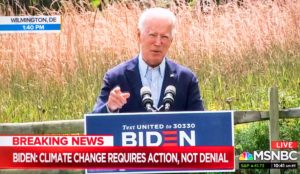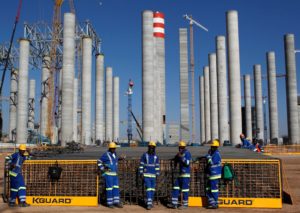Developing countries watched with apprehension as US president Joe Biden hosted 41 world leaders at the Leaders Summit on Climate on 22-23 April. With an overriding goal to curb emissions and limit global warming to two degrees Celsius above pre-industrial levels, as agreed at the Paris climate summit in 2015, individual leaders declared their ambitions to tackle the climate crisis – while also setting the tone for cooperation on climate with the Biden administration.
As the host and the world’s second-largest emitter, the US led the announcements with a target of halving emissions before 2030 compared with 2005 levels. Though this was largely welcomed by global leaders at the summit, it has been criticised as “woefully short of what’s necessary” to address the climate emergency. Ahead of the climate summit, Biden’s pledge of USD 2.5 billion for international climate finance was also viewed with scepticism by South Asia analysts, who said it was inadequate for climate justice.
At the summit, China and India were among the major polluters who signalled their intent to pursue green energy. President Xi Jinping vowed to “strictly control” coal power in the next five years and promote greener investments through the Belt and Road Initiative, but avoided a comprehensive statement on ending coal finance in BRI projects. India shied away from declaring a net-zero target year, but affirmed the country’s pledge to install 450 gigawatts of renewable energy by 2030.
As the US calls on all countries to do more to limit emissions and pledges its support to meet climate goals in developing countries, big polluters and climate-vulnerable nations in Asia grapple with what this means for livelihoods, growth and development.
The Third Pole asked experts from countries represented at the climate summit for their thoughts on what the outcomes mean for hope and cooperation in the coming decade.
Ulka Kelkar

Director of the climate programme at World Resources Institute India
The announcements made at the climate summit convened by President Biden are important because they come in the aftermath of a devastating pandemic and economic crisis. A year ago, when we were in the throes of the first wave of the pandemic, we did not know if countries might sacrifice climate action in the interest of economic recovery. Today, thanks to this summit, we know that all countries have reaffirmed their commitment to climate action, and to the ultimate goal of the Paris Agreement.
Though the announcements made at this summit need to be implemented over the next decade and more, the most important of these was the US pledge to reduce its emissions by roughly half by 2030 and net-zero by 2050. As the world’s biggest contributor to climate change, the US’s participation is key to global climate action. The EU and UK not only made ambitious pledges but have already enshrined them in law, which is a very significant example for other nations to emulate. The financial pledges made at this summit, however, leave much to be desired. India’s speech at this summit repeated its existing domestic and international commitments. With the US, it announced a new Climate and Clean Energy Agenda 2030 Partnership to mobilise investments in clean technologies.
Liu Yuanling

Assistant researcher at the Institute of American Studies, Chinese Academy of Social Sciences
Combating climate change won’t be successful without Sino-US cooperation. The two countries rebooting their collaboration has sent a very positive signal. China and the US announced the implementation of the Kigali Amendment to strengthen control of greenhouse (refrigerant) gases. This has greatly boosted global confidence in a year that is critical for climate change. However, cooperation between the two sides also faces challenges. The time left for us to fight climate change is pressing. China and the US bring different perspectives on climate issues, such as lack of mutual trust, unequal actions, investment in funding and capacity building. Their bilateral relations have not improved even after Biden took the stage. Climate issues, which have long been highly politicised, are bound to be affected by the current bad bilateral relations. The two countries also lack young talented successors. The current leaders of Sino-US climate cooperation are veterans such as Xie Zhenhua and John Kerry, who have enthusiasm, passion and even a certain sense of mission for climate issues. Whether there will be similar successors in the future is uncertain.
The Kigali Amendment is an amendment to the Montreal Protocol which is meant to protect the ozone layer, the part of the Earth’s atmosphere that absorbs most of the sun’s ultraviolet radiation. Countries have agreed to reduce production and consumption of hydrofluorocarbons (HFCs) by more than 80% over the next 30 years. This phaseout is also of huge importance to the climate, as HFCs are greenhouse gases with a warming impact thousands of times higher than carbon dioxide.
Jean Su

Director of energy justice programme at the Center for Biological Diversity, US
President Biden’s pledge to cut domestic emissions 50-52% by 2030 falls woefully short of what’s necessary to meet the massive scale of the climate emergency. Solving the climate crisis requires applying both science and equity. The US is the largest historic polluter and one of the wealthiest nations, and it must do its fair share and slash domestic emissions by at least 70% by 2030 and substantially finance the global south’s decarbonisation to pay the balance of its hefty climate debt. Combating the climate emergency at home also requires transforming our economy by moving immediately to end the fossil fuel era and create a renewable and anti-racist energy system that advances justice first.
Navroz Dubash

Professor at the Centre for Policy Research, India
The noteworthy shift signalled by the climate summit is that a lot of political weight is placed on near-term 2030 actions consistent with long-term net-zero objectives. This is a useful signal, as future targets, while important, should not release pressure for action today. This shift makes it more likely that short-term policy and long-term target-setting will reinforce each other.
For countries making updated pledges, the task now is to lay out clearly and credibly their implementation pathway, including how they will ensure climate pledges do not shift with national political winds. This is, of course, a particular challenge for the US, where climate legislation still looks unlikely.
For countries that have not made updated pledges as yet, including India, the task is clear: devise pledges that demonstrate short-term intent to transform, ideally embed that in a long-term signal aimed at net-zero, and lay out clear and credible policies to get there.
Many countries, including India, do not have the institutional structures to undertake these tasks and building these institutions is a first order of priority. India now has three priorities. First, develop clear, implementable plans for shifting our development pathway in key sectors, led by the electricity sector. These shifts should emphasise development gains, such as employment creation and local air pollution, along with carbon emission limits. Second, as part of an electricity plan, it is time for India to look at capping coal power capacity, along with enhancing renewable energy capacity, and upgrading the grid. But to do this we also need a transition plan for coal-dependent states. Third, to undertake sector plans, and to relate them to long-term objectives, India needs to urgently create an independent analytical body that also sparks informed public conversation about building a low-carbon economy of the future.
Zou Ji

President of Energy Foundation China
I have high expectations that China-US climate cooperation will return to the level of Obama’s presidency. At that time, several joint statements by the two leaders were made in succession. If China and the United States can continue to cooperate sincerely and pragmatically, they would issue joint statements in the name of the top leaders. In this case, the specifications, strength and influence will be higher.
The two countries have committed to reduce the consumption of fossil fuels such as coal, oil and natural gas. This is the first time that they clearly list the types of fossil fuels in the joint statement. China must work to control the use of coal, reduce the proportion of coal in its energy sector, and introduce more renewable energy. While in the US, reducing the consumption of oil and natural gas is the main contradiction. China and the US could cooperate to limit and reduce the consumption of fossil fuels.
Shahab Enam Khan

Professor, Department of International Relations at Jahangirnagar University, Bangladesh
South Asian countries are at a crossroads at the moment. If governments maintain the pre-Covid-19 attitude towards environmental security and climate change, the post-Covid-19 world will continue to put multiple non-traditional stressors on them. These countries must come out of a “talk shop” attitude on the environment. They need a collective response and collaborative approach ranging from water governance and maritime cooperation to sustainable ecosystems. Courageous steps to shift from a carbon-based energy system to renewable and innovative energy infrastructure ought to be taken. Regional commitment actions under BIMSTEC (Bay of Bengal Initiative for Multi-Sectoral Technical and Economic Cooperation) and SAARC (South Asian Association for Regional Cooperation) for this decisive decade should materialise. The political leadership [of SAARC countries] should be reminded that climate change is no longer an issue of bureaucratic politics but an existential threat that needs commitments to emissions cuts with clear planning for net zero.
Fahad Saeed

Regional climate scientist, Climate Analytics, Pakistan
We welcome President Biden’s strong commitment to substantially reduce emissions by 2030. However, the world has lost four very important years of climate action during the previous US administration. This is very significant because with each year of climate inaction, the impacts of climate change worsen and developing countries bear the brunt. We, therefore, expect the US to catch up not only for lost time but also to ramp up efforts in providing support to developing countries in terms of climate finance, capacity building and technology transfer.
Though Pakistan’s contribution to global emissions is less than 1%, climate change remains a high priority agenda. Being at the forefront of the countries affected by climate change, there is no room for complacency for Pakistan. Besides its flagship 10 billion tree afforestation project, Pakistan must develop stringent policies and action plans to minimise the share of fossils in its energy system. Previous research has shown that a transformation towards renewables comes with benefits such as new jobs, improved health quality, reduction of import bills, provision of off-grid electricity etc. Pakistan must abandon the technologies of the past and prepare itself to ride the upcoming wave of renewables.
Barbara Finamore

Asia senior strategic director at the Natural Resources Defense Council, US
President Xi’s commitments to strictly control coal-fired power generation projects, and strictly limit the increase in coal consumption over the 14th Five Year Plan are promising. The next step in reaching China’s climate goals would be to lay out detailed sectoral five-year plans that: 1) halt the construction of new coal plants, 2) adopt a reasonable timetable for the retirement of existing plants, and 3) set absolute caps on coal consumption and CO2 emissions. China can also align its overseas investment policies with its domestic climate ambitions by following the example of South Korea in ending overseas coal finance. Instead, as the world leader in renewable energy, China has much to offer other developing countries in accelerating their transition to green and low-carbon development.









![Indian father riding on at electric three wheeler with his child [image: Suman Kumar / Alamy]](https://dialogue.earth/content/uploads/2021/05/2BHEFB6-300x200.jpg)